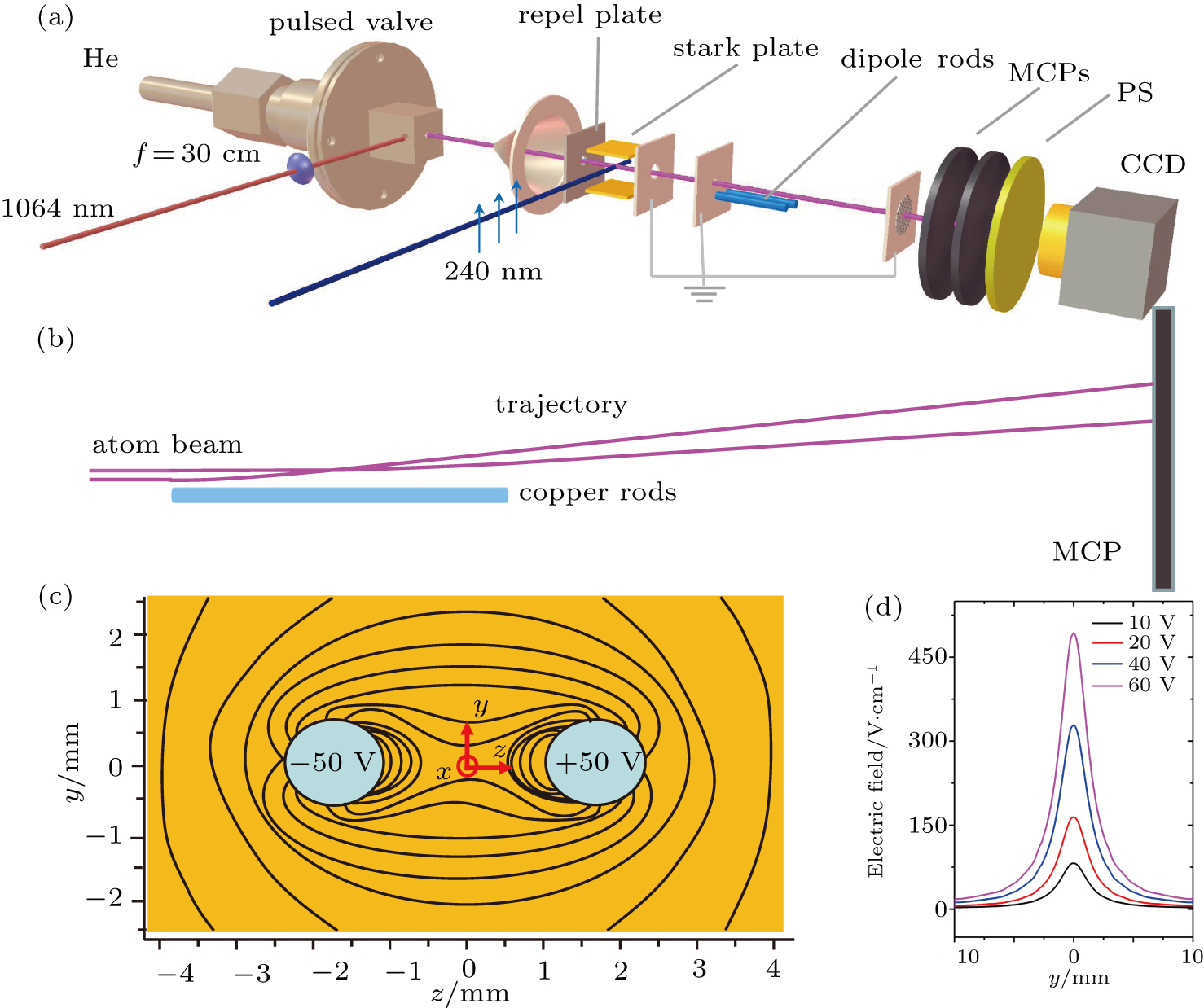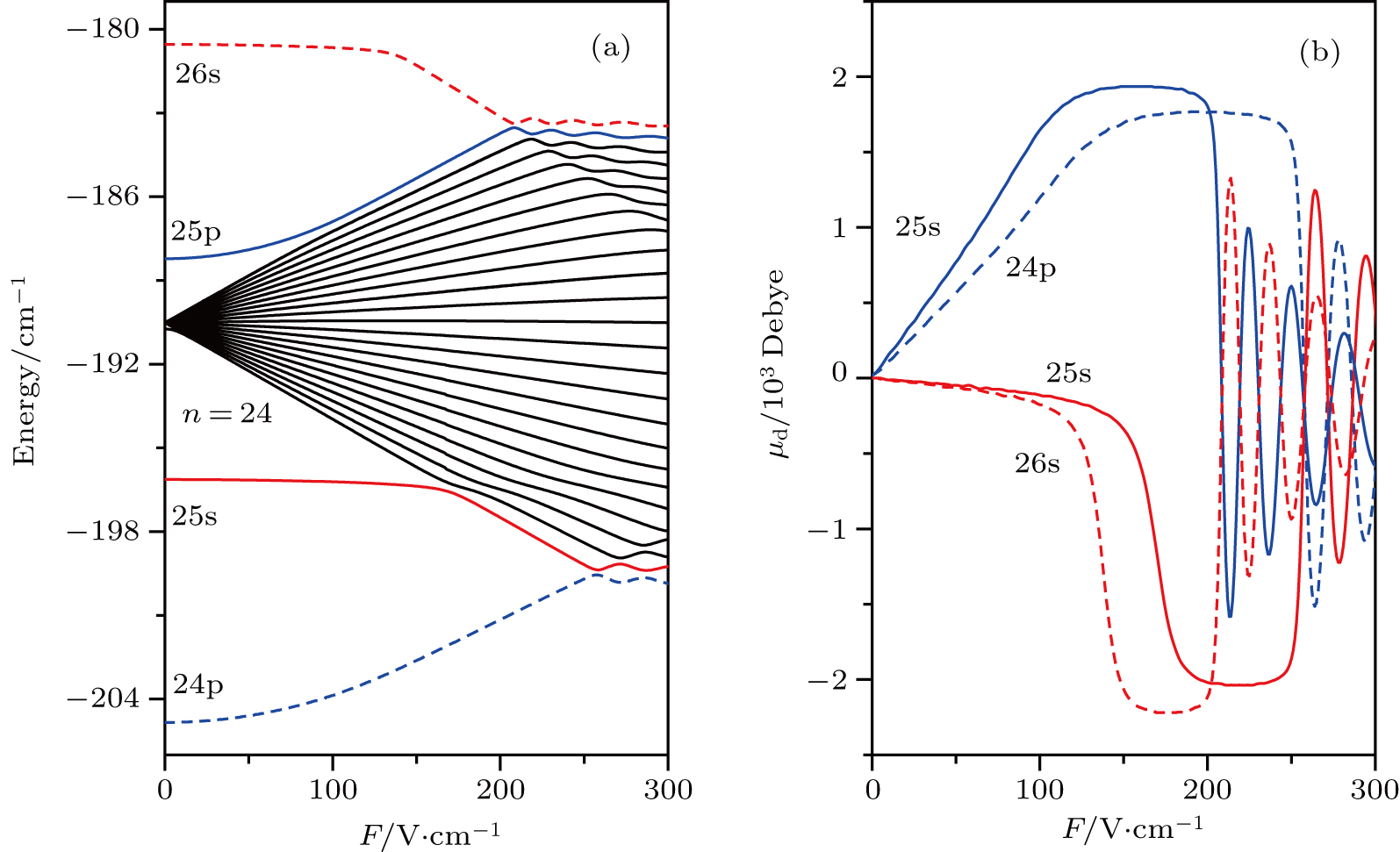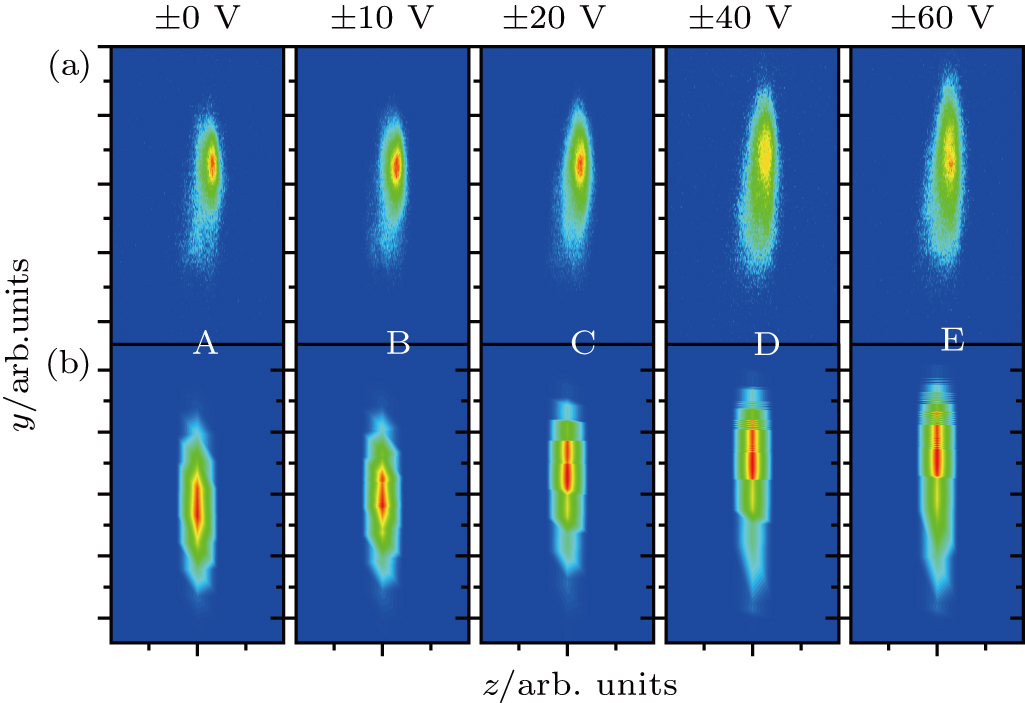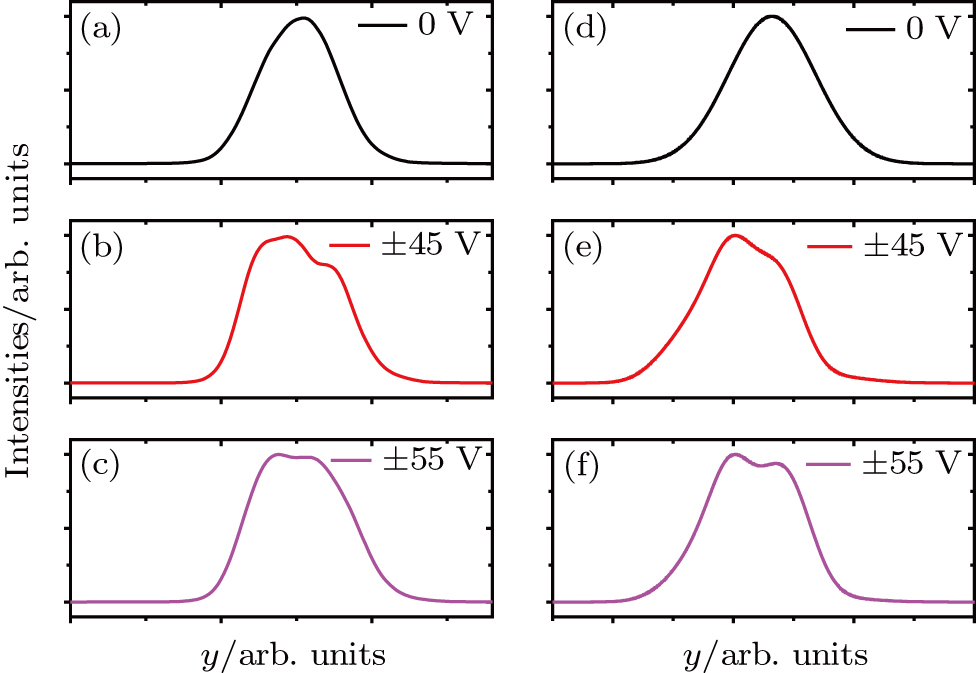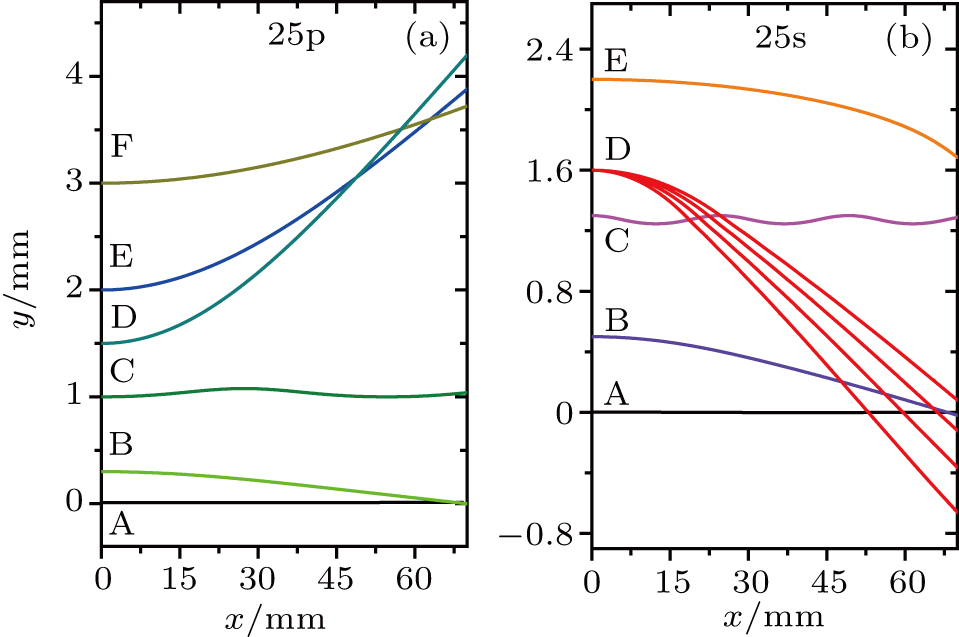† Corresponding author. E-mail:
Project supported by the National Natural Science Foundation of China (Grant Nos. 91421305, 91121005, and 11674359) and the National Key Basic Research Program of China (Grant No. 2013CB922003).
We report a sensitive detection of high Rydberg atom with large dipole moment utilizing its deflection near a pair of parallel cylindrical copper rods which are oppositely charged. When the low-field seeking state Rydberg atoms fly across the gradient electric field formed by the pair of rods, they will be pushed away from the rods while the high-field seeking state ones will be attracted towards the rods. These atoms will form different patterns on an ion imaging system placed downwards at the end of the rods. The spatial distribution of the deflected atoms on the imaging system is also simulated, in good agreement with the experimental results, from which we can deduce the quantum state information of the excited atoms. This state resolvable Rydberg atom detection can be used for the dynamics research of the dipole–dipole interaction between atoms with large dipole moments.
As an interesting and accessible system, Rydberg atoms in external fields have been an intensively studied subject in the physical realization of quantum simulation[1] and quantum information process.[2] Rydberg atoms with large electric dipole moments provide an opportunity for efficient control of their translational motion using inhomogeneous electric fields, leading to the experimental achievement of atomic guides,[3,4] mirrors,[5] lenses,[6] and traps.[7–9] In all processes, the quantum-state selection and detection of Rydberg atoms is essential to determine the population of prepared Rydberg states, which is required to read out the information of the quantum operations for quantum information processing.[1,2] The technique of the deflection of Rydberg atoms with a significant dipole moment in inhomogeneous electric fields proves an efficient way to selectively detect the internal states of neutral Rydberg atoms.[10,11]
The deflection of Rydberg atoms in inhomogeneous magnetic fields was first demonstrated in the classic Stern–Gerlach experiment in the 1920s.[12] In an external inhomogeneous electric field, the Rydberg atoms experience a force given by[13]
In this paper, we extend this technique to metal atoms, i.e., sodium, and demonstrate its applicability in a gradient electric field. This extending research is very important since metal atoms such as the sodium atom have a very low ionization potential energy, easily accessible to highly excited states through a one-photon excitation process and its spectroscopy in Rydberg states in electric fields has been extensively studied.[13,20–23]
The experimental setup is based on the previous work,[24] and only the altered parts are detailed here. The kernel schematic diagram is shown in Fig.
After being ejected into the second chamber, the atom beam is intersected by a UV laser beam at right angles in the region of a homogeneous field, where sodium atoms are excited from the ground state to a selected Rydberg state (n = 20–35) via a single-photon excitation process. The crossing point of the laser and atomic beam is located just in the middle of a pair of parallel Stark plates (10 mm × 10 mm) as shown in Fig.
The photoexcited Rydberg atoms continue their flying journey in an inhomogeneous field of paralleled copper cylindrical rods (length 70 mm, diameter 1.2 mm, center-to-center spacing 3.2 mm), located approximately 2 mm below the atomic beam. Rydberg atoms are deflected away or attracted towards the rods depending on whether they were excited to a low- or a high-field seeking Stark state. These trajectory-altered Rydberg atoms freely fly a distance of about 400 mm until arriving at an ionization region. In this field-free journey of flight, the atoms do not feel the deflecting force any longer but their space deflection perpendicular to the flight can be linearly magnified. After passing over the free flight region, the atomic beam enters the field-ionization region consisting of a fine-mesh grid and a pair of MCPs between which high voltage is applied to ionize the atoms. The MCPs are coupled to a P43 phosphor screen of fluorescence (lifetime ∼ 1.2 ms). The arrival of the ions can be imaged with a lens-coupled gated CCD camera (CoolSNAP HQ2, 8.98 × 6.71 mm2) with spatial resolution 6.45 × 6.45 μm2 pixels. The track history is diagramed in Fig.
Specially, the electric field induced by the electrodes at opposite charge voltage V = ±50 V is simulated in a plane perpendicular to the rods and schematically shown in Fig.
To investigate the motion of Rydberg atoms in an inhomogeneous radial electric field surrounding a pair of copper rods, we select two states of large dipole moments but with opposite signs, i.e., 25p and 25s states belonging to the low- and high-field seeking states, respectively. The Stark maps and their dipole moments μd are shown in Figs.
In Fig.
The force exerted on Rydberg–Stark atoms is proportional to the multiplication of the dipole moment and the gradient electric field. Compared with the 25p state, the 25s one is deflected towards the high-field region because the energy decreases with electric field strength. The 25s state (red lines in Fig.
We firstly excite the atom onto the Rydberg state 25p and study its kinetic behavior in the gradient electric field. The experimental result and theoretical simulation are shown in Figs.
Different from the mediocre deflection for the 25p state away from the rods, the deflection for the 25s state is towards the center line of the rod pair for an attraction force and shows a strong clipping effect for the image. The atomic image at zero deflection electric field is shown in Fig.
This clipping effect on the image for the 25s state is dependent on the applied voltages on the rods. The integrated signals along y from experiment and simulation are shown in Figs.
The mediocre deflection for the 25p state away from the rods and the deflection for the 25s state with the clipping effect can be well explained by the atomic dipolar interaction with the applied gradient field. A simulation of the atomic dynamic kinetic movement close to the rods in real size scale is shown in Fig.
For atoms in state 25s, this deflection is more sensitive to the initial incident distance y(t = 0) as shown in Fig.
In an ideal case, we can narrow the beam size to the μm scale, i.e., 100 μm, and observe only the Rydberg atoms starting at an exactly given y(t = 0) point. Therefore, the deflection of atom can be clearly seen on the image without background disturbing. However, for metal atoms, we cannot do this by narrowing the beam diameter to this size as the metal atom will deposit on the skimmer pin hole of small size and block it. This is different from the previous work for Kr,[16] where Kr is naturally in gas state and an application of small size pin hole is possible. As a result, our recorded image has a Gaussian background formed by the mediocre atoms which are not deflected at all or only a little deflected for the large beam size used. Even so, however, the unique scattering feature of atom in state 25s can avoid this disadvantage caused by the usage of metal atoms since its deflection trajectory is extremely sensitive to the initial position perpendicular to the beam, namely, y(t = 0), at the starting moment.
During the flight journey, it is possible for Rydberg atoms to get ionized due to the dipole-dipole interaction between them, but all ions generated in the collision are blown away perpendicularly by the applied field and invisible for the image detection system.
In summary, we demonstrate the deflection of a metal atom, i.e., sodium, on the Rydberg state in a gradient electric field formed by a pair of parallel cylindrical copper rods. In the experiment, the Rydberg sodium atoms are prepared onto the red/blue state in appropriate Stark fields, typically possessing the large induced dipole moments we are interested in. Particularly, the red state atom belonging to the high-field seeking state is attracted towards the dipole rods while the blue state atom belonging to the low-field seeking state is deflected away. In more detail, the force exerted on an atom is positively determined by the multiplication of the instantaneous induced dipole moment and the gradient of the electric field, thus providing a state sensitive detection of the Rydberg atom. The pair of rods can be geometrically designed to a small size and the maximum deflection occurs only in a very narrow space along the gradient direction, thus it can also be taken as a detector to monitor the specific group of an atom in situ, especially for metal atoms.
| [1] | |
| [2] | |
| [3] | |
| [4] | |
| [5] | |
| [6] | |
| [7] | |
| [8] | |
| [9] | |
| [10] | |
| [11] | |
| [12] | |
| [13] | |
| [14] | |
| [15] | |
| [16] | |
| [17] | |
| [18] | |
| [19] | |
| [20] | |
| [21] | |
| [22] | |
| [23] | |
| [24] | |
| [25] | |
| [26] |


